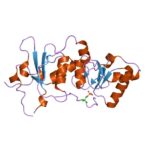A GPS View of the Human Genome
Taking cues from global positioning satellites, Yuval Itan, PhD, a postdoctoral researcher at Rockefeller University and his colleagues have created the “human gene connectome” (HGC), unveiled in Proceedings of the National Academy of Sciences.
A MAP BASED ON FUNCTION
Researchers have been deducing gene lineages for decades, based on DNA sequence similarities that presumably reflect descent from shared ancestors. Dr. Itan’s approach is different: he’s looking for shared physiology, or “biological proximity.” That’s when a set of genes is related functionally to one core gene that’s already implicated in a particular disease.
Like evolution, the strategy uses existing information in a novel way. Dr. Itan works in the lab of Jean-Laurent Casanova, MD, PhD, at the St. Giles Laboratory of Human Genetics of Infectious Diseases. The group’s goal is to identify “monogenic holes” in the immune defense that make otherwise well children highly susceptible to specific devastating, life-threatening infectious diseases. With colleagues from Necker Hospital for Sick Children, the Pasteur Institute, and Ben-Gurion University, the researchers teamed the Dijkstra algorithm – developed in the 1950s and used in GPS technology – with other public databases: String (5 million protein-protein interactions), FunCoup (model organisms protein connections), and HumanNet (18,000 human gene interactions).
Researchers have used HumanNet to evaluate genome-wide association study (GWAS) data to analyze polygenic diseases, in which many genes contribute to small and unequal degrees to an illness. In contrast, Dr. Itan focused on single-gene (Mendelian) diseases, and considered only gene pairs related by shared function shown empirically, not simply shared sequences. He used these observable connections to assign distances between genes.
“It was exactly like driving from New York to Texas. GPS software does this using the same type of information that I have, the algorithm finds shortest way to get there. So why not use the same approach to navigate better between genes?” Dr. Itan asked. Facebook’s ability to connect people through shared contacts also influenced his metaphorical thinking of finding genes that are all functionally related to one core gene, and not to each other.
So the researchers tested the idea.
GENE DISCOVERY
Case #1: The Toll-like receptor 3 (TLR3) gene, discovered in the Casanova lab years earlier, causes the life-threatening brain inflammation herpes simplex virus 1 encephalitis (HSE) in children. TLR3 controls innate immunity, impairing a specific interferon.
The human gene connectome produced results both expected and not. “We took 2 patients who had HSE and had very recently been discovered to have a disease-causing gene called TBK1,” Dr. Itan told me. “So we thought if we take gene variations and run them by their distance to TLR3, would TBK1 show up? In both patients, it showed up first, purely based on this computational prediction.” The TLR3-specific connectome revealed two novel TLR3 pathway genes prior to their experimental validation — EFGR and SRC.
In a second test case, a mutation in a collagen gene that causes a form of Ehlers-Danlos syndrome pulled out 26 other genes associated with the Ehlers-Danlos syndrome and its genetic pathway.
Finding new genes behind what was thought to be a single-gene disease can identify new pathways for pharmaceutical interrogation, and perhaps suggest repurposing of existing drugs. And as in most genomic matters, power and possibilities will grow as other researchers contribute data, and the connections expand.
Dr. Itan sees the human gene connectome as not just a research tool, but as a way to cut through the needle-in-a-haystack situation that clinical sequencing in today’s early guise can impose. If a patient’s symptoms don’t match anything in a physician’s experience, the HGC can save time. “Until now you’d have to go through the literature and look at hundreds of genes. It could take months.” Dr. Itan can’t patent the human gene connectome, because, at the risk of a double negative, it isn’t non-obvious, and it’s based on publicly available information.
A practical application of the human gene connectome was in my blog from a few weeks ago, although I didn’t know of it yet — diagnosing novel forms of a single-gene disease.
Genetic heterogeneity is when mutation in more than one gene can cause a phenotype (disease or trait). The blog mentioned parents of a child with osteogenesis imperfecta (“brittle bone disease”) accused of abuse because they carry unknown mutations and therefore are negative on a standard genetic test. Hemophilia is another example, with different forms of the blood clotting disorder resulting from mutations that disable different enzymes.
Not recognizing that mutations in different genes can have the same clinical consequences can lead to false assurances from genetic testing. This is the case for the BRCA1 breast cancer gene. A person can be tested through a health care provider using the Myriad Genetics test, or for the most common mutations through the direct-to-consumer company 23andMe, and if no mutations show up, think all is well. But BRCA1 interacts with several other genes, all part of the pathways that repair DNA. Mutations in those genes can cause breast cancer too.
I’ve gotten a lot of flak for blogging that I don’t want to know my genome sequence. My primary reason is that the information isn’t reliable until we know all gene-gene interactions. Now, thanks to the human gene connectome, we’re on the way to working out all the ways that genes can cause disease. I might have to get my sequence done after all.


Why we must consider the complete HUMAN GENOME as a “W H O L E” ?
http://www.scirp.org/journal/PaperInformation.aspx?PaperID=37457
from SCIRP scientific research APPLIED MATHEMATICS (BIOMATHEMATICS issue
10B Octoner 2013) website
http://www.scirp.org/journal/AM/%5Bimage: Inline
image 1]